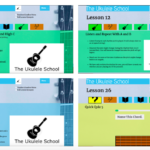We have all been there, we’re playing a new song and suddenly there is a chord which looks more like a set of coordinates on a map. The E7#9 chord is an extreme version and really isn’t that common unless you’re a certain Mr Hendrix. In fact, the E7#9 is often referred to as the Hendrix chord, it’s used on his song Purple Haze.
Perhaps a more common chord we might see is the Major 7 or minor 7 chord. The problem is, how do I play these chords if I don’t want to get tangled up in the theory and just don’t know the shape on the ukulele?
The answer is simple: we don’t play all of the extra bits of the chord so a Cmaj7 chord can be played as a simple C. An Amin7 chord can be played as a simple Am chord.
But what, I hear you ask about the Hendrix chord and others like it, D7#11 anyone?
These chords are what we call altered chords, essentially they have extra notes added which are then altered, so raised (#) or lowered (b) so A7b13. These chords present a unique problem on the ukulele as the previous chords Maj7 and Minor 7 are 4 note chords and so are possible to play on the ukulele. However, a E7#9 is technically a 5 note chord, fine if you’re a piano player with 10 fingers or a guitarist with 6 strings but not so easy on a ukulele with 4 strings.
On the ukulele there really is only one solution and that is to simplify the chord. An E7#9 is just an E7 chord with some garnish added for some extra colour. So if you know an E7 chord play that, if not you can just play the E chord. This works because at their heart all chords are just triads (three note chords), this means we can boil down all these exotic sounding chords to just the basic chords we can already play. Doing this does mean we might not get some of the interesting colours but we can still hear the song.
So how do we play an E7#9 chord on the ukulele? The answer is, you don’t. You boil it down to a simple E7 or an even easier E triad. In this article I have outlined a way of simplifying these chords. If however you did want to play the ‘proper’ chord you can check out our 10 second chord series on YouTube, which will cover these chords.

